Innovative Energy Management System for MVDC Networks with Black-Start Capabilities
Abstract
1. Introduction
1.1. Problem Definition
- (a)
- Connecting dump loads at the DC bus to absorb the excess power [12]: this approach requires installing expensive variable controllable loads that track the power output from the RES to attain voltage stability, making it a complex and expensive option.
- (b)
- Controlling the RES output to match the DC link voltage requirements [13,14,15]. This approach requires shifting the RES operating mode between maximum power point tracking (MPPT) and voltage regulation (VR) based on the network conditions, in addition to achieving adequate power sharing in case of multiple operating RES units.
1.2. EMS Design State-of-the-Art
- (a)
- (b)
- Designing the isolated EMS for batteries state of charge (SoC) optimization and lifecycle extension, without considering the described special operating cases [18].
- (c)
- Designing the system with RES mode shift between MPPT and VR taken into consideration, but without accounting to load shedding under light supply conditions [14].
- (d)
- Considering the load shedding requirement in the design for the whole load as a bulk, without taking load prioritizing into account to prolong critical loads supply [19].
1.3. Paper Scope and Contributions
- (a)
- New innovative EMS that achieves a robust isolated DC distribution system operation with elongated critical load supply period with the ability to implement power sharing between multiple RES units under oversupply condition or maximum battery power limit violation.
- (b)
- The inclusion of black-start and power synchronizing functionalities within the EMS to participate in AC network restoration through the central interfacing converter.
2. Proposed Energy Management System
3. Proposed EMS Operating Modes
3.1. Maximum Power Point Tracking Modes
3.1.1. Load Shedding Path
3.1.2. Load Restoration Path
3.2. Voltage Regulation Operating Mode
3.3. Black-Start/AC Synchronization Modes
- (a)
- Always maintaining a minimum battery SoC during isolated MVDC operation, where definition should be set based on network planning and contracted capacity with the utility.
- (b)
- Applying modified grid-forming control to the interface converter with ramping voltage reference between 0 and 1 pu between time and to gradually energize the connected network’s AC transformer and avoid inrush current flow. Equation (9) defines the ramping AC voltage requirement. The ramping time is set in accordance with transformer parameters, such as the residual flux and damping time constant to avoid saturation at lower ramping times.
- (c)
- Matching the AC voltage magnitude, frequency, and phase to the neighboring energized AC network before synchronizing both areas. A common synchronizing requirement from IEEE is summarized in [35]. For further protection, an additional switch is added that is monitored and manually set to 1 when synchronization conditions are achieved before closing the STS as defined in Equation (10).where indicate the grid-code defined reconnection margin for voltage magnitude, frequency, and phase angle, respectively, and the subscript denotes the MVDC distribution system.
4. Proposed EMS Design Verification: Case Studies
4.1. Case Study 1: EMS Test with Multiple RES Units (Power Sharing)
4.1.1. RES Mode Shift and Power Sharing Test
4.1.2. Load Shedding/Restoration Test
4.1.3. Black-Start/Transformer Energization
4.1.4. Grid Synchronization Test
4.2. Case Study 2: Proposed EMS Experimental Verification
4.2.1. Proposed EMS Experimental Voltage Regulation Test
4.2.2. Grid Synchronization Test
5. Conclusions
Author Contributions
Funding
Data Availability Statement
Acknowledgments
Conflicts of Interest
References
- Henbest, S. New Energy Outlook 2019; Bloomberg New Energy Finance: New York, NY, USA, 2019. [Google Scholar]
- Alassi, A.; Bañales, S.; Ellabban, O.; Adam, G.; MacIver, C. HVDC Transmission: Technology Review, Market Trends and Future Outlook. Renew. Sustain. Energy Rev. 2019, 112, 530–554. [Google Scholar] [CrossRef]
- Zhang, S.; Zhou, M.; Li, G. Applying power margin tracking droop control to flexible operation of renewables generation multi-terminal DC collector system. CSEE J. Power Energy Syst. 2020, 1–10. [Google Scholar] [CrossRef]
- Siddique, H.A.B.; Doncker, R.W.D. Evaluation of DC Collector-Grid Configurations for Large Photovoltaic Parks. IEEE Trans. Power Deliv. 2018, 33, 311–320. [Google Scholar] [CrossRef]
- Chuangpishit, S.; Tabesh, A.; Moradi-Shahrbabak, Z.; Saeedifard, M. Topology Design for Collector Systems of Offshore Wind Farms with Pure DC Power Systems. IEEE Trans. Ind. Electron. 2014, 61, 320–328. [Google Scholar] [CrossRef]
- MVDC Plus: Medium Voltage Direct Current Managing the Future Grid; Siemens: Munich, Germany, 2017.
- Steinke, J.K.; Maibach, P.; Ortiz, G.; Canales, F.; Steimer, P. MVDC Applications and Technology. In Proceedings of the PCIM Europe 2019 International Exhibition and Conference for Power Electronics, Intelligent Motion, Renewable Energy and Energy Management, Nuremberg, Germany, 7–9 May 2019; pp. 1–8. [Google Scholar]
- Yu, J.; Smith, K.; Urizarbarrena, M.; Bebbington, M.; Macleod, N.; Moon, A. Initial designs for ANGLE-DC project: Challenges converting existing AC cable and overhead line to DC operation. CIRED Open Access Proc. J. 2017, 2017, 2374–2378. [Google Scholar] [CrossRef]
- Hunter, L.; Booth, C.; Ferre, A.J.; Finney, S. MVDC for enhanced utility scale distribution power delivery and control. In Proceedings of the 2017 52nd International Universities Power Engineering Conference (UPEC), Heraklion, Greece, 28–31 August 2017; pp. 1–6. [Google Scholar]
- Aki, H. Demand-Side Resiliency and Electricity Continuity: Experiences and Lessons Learned in Japan. Proc. IEEE 2017, 105, 1443–1455. [Google Scholar] [CrossRef]
- Marnay, C.; Aki, H.; Hirose, K.; Kwasinski, A.; Ogura, S.; Shinji, T. Japan’s Pivot to Resilience: How Two Microgrids Fared after the 2011 Earthquake. IEEE Power Energy Mag. 2015, 13, 44–57. [Google Scholar] [CrossRef]
- Kumar, J.; Agarwal, A.; Singh, N. Design, operation and control of a vast DC microgrid for integration of renewable energy sources. Renew. Energy Focus 2020, 34, 17–36. [Google Scholar] [CrossRef]
- Augustine, S.; Mishra, M.K.; Lakshminarasamma, N. A Unified Control Scheme for a Standalone Solar-PV Low Voltage DC Microgrid System with HESS. IEEE J. Emerg. Sel. Top. Power Electron. 2020, 8, 1351–1360. [Google Scholar] [CrossRef]
- Sahoo, S.; Mishra, S.; Jha, S.; Singh, B. A Cooperative Adaptive Droop Based Energy Management and Optimal Voltage Regulation Scheme for DC Microgrids. IEEE Trans. Ind. Electron. 2020, 67, 2894–2904. [Google Scholar] [CrossRef]
- Alassi, A.; Ellabban, O. Design of an Intelligent Energy Management System for Standalone PV/Battery DC Microgrids. In Proceedings of the 2019 2nd International Conference on Smart Grid and Renewable Energy (SGRE), Doha, Qatar, 19–21 November 2019; pp. 1–7. [Google Scholar]
- Dos Santos Neto, P.J.; dos Santos Barros, T.A.; Silveira, J.P.C.; Filho, E.R.; Vasquez, J.C.; Guerrero, J.M. Power Management Strategy Based on Virtual Inertia for DC Microgrids. IEEE Trans. Power Electron. 2020, 35, 12472–12485. [Google Scholar] [CrossRef]
- Marín, L.G.; Sumner, M.; Muñoz-Carpintero, D.; Köbrich, D.; Pholboon, S.; Sáez, D.; Núñez, A. Hierarchical Energy Management System for Microgrid Operation Based on Robust Model Predictive Control. Energies 2019, 12, 4453. [Google Scholar] [CrossRef]
- Vásquez, L.O.P.; Ramírez, V.M.; Thanapalan, K. A Comparison of Energy Management System for a DC Microgrid. Appl. Sci. 2020, 10, 1071. [Google Scholar] [CrossRef]
- Benlahbib, B.; Bouarroudj, N.; Mekhilef, S.; Abdeldjalil, D.; Abdelkrim, T.; Bouchafaa, F.; lakhdari, A. Experimental investigation of power management and control of a PV/wind/fuel cell/battery hybrid energy system microgrid. Int. J. Hydrog. Energy 2020, 45, 29110–29122. [Google Scholar] [CrossRef]
- Dos Santos Neto, P.J.; Barros, T.A.S.; Silveira, J.P.C.; Ruppert Filho, E.; Vasquez, J.C.; Guerrero, J.M. Power management techniques for grid-connected DC microgrids: A comparative evaluation. Appl. Energy 2020, 269, 115057. [Google Scholar] [CrossRef]
- Matayoshi, H.; Kinjo, M.; Rangarajan, S.S.; Ramanathan, G.G.; Hemeida, A.M.; Senjyu, T. Islanding operation scheme for DC microgrid utilizing pseudo Droop control of photovoltaic system. Energy Sustain. Dev. 2020, 55, 95–104. [Google Scholar] [CrossRef]
- Batiyah, S.; Sharma, R.; Abdelwahed, S.; Zohrabi, N. An MPC-based power management of standalone DC microgrid with energy storage. Int. J. Electr. Power Energy Syst. 2020, 120, 105949. [Google Scholar] [CrossRef]
- Liu, B.; Zhuo, F.; Zhu, Y.; Yi, H. System Operation and Energy Management of a Renewable Energy-Based DC Micro-Grid for High Penetration Depth Application. IEEE Trans. Smart Grid 2015, 6, 1147–1155. [Google Scholar] [CrossRef]
- Mirzaei, A.; Forooghi, M.; Ghadimi, A.A.; Abolmasoumi, A.H.; Riahi, M.R. Design and construction of a charge controller for stand-alone PV/battery hybrid system by using a new control strategy and power management. Sol. Energy 2017, 149, 132–144. [Google Scholar] [CrossRef]
- Cai, H.; Xiang, J.; Wei, W. Decentralized Coordination Control of Multiple Photovoltaic Sources for DC Bus Voltage Regulating and Power Sharing. IEEE Trans. Ind. Electron. 2018, 65, 5601–5610. [Google Scholar] [CrossRef]
- Chowdhury, N.; Pilo, F.; Pisano, G. Optimal Energy Storage System Positioning and Sizing with Robust Optimization. Energies 2020, 13, 512. [Google Scholar] [CrossRef]
- Ellabban, O.; Alassi, A. Optimal hybrid microgrid sizing framework for the mining industry with three case studies from Australia. IET Renew. Power Gener. 2021, 15, 409–423. [Google Scholar] [CrossRef]
- Wei, J.; Zhang, Y.; Wang, J.; Cao, X.; Khan, M.A. Multi-period planning of multi-energy microgrid with multi-type uncertainties using chance constrained information gap decision method. Appl. Energy 2020, 260, 114188. [Google Scholar] [CrossRef]
- Cui, H.; Li, F.; Fang, X.; Chen, H.; Wang, H. Bilevel Arbitrage Potential Evaluation for Grid-Scale Energy Storage Considering Wind Power and LMP Smoothing Effect. IEEE Trans. Sustain. Energy 2018, 9, 707–718. [Google Scholar] [CrossRef]
- Shim, J.W.; Verbič, G.; Zhang, N.; Hur, K. Harmonious Integration of Faster-Acting Energy Storage Systems into Frequency Control Reserves in Power Grid with High Renewable Generation. IEEE Trans. Power Syst. 2018, 33, 6193–6205. [Google Scholar] [CrossRef]
- Chang, W.-Y. The State of Charge Estimating Methods for Battery: A Review. ISRN Appl. Math. 2013, 2013, 953792. [Google Scholar] [CrossRef]
- Pagnani, D.; Blaabjerg, F.; Bak, C.L.; da Faria Silva, F.M.; Kocewiak, Ł.H.; Hjerrild, J. Offshore Wind Farm Black Start Service Integration: Review and Outlook of Ongoing Research. Energies 2020, 13, 6286. [Google Scholar] [CrossRef]
- Black Start from Non-Traditional Generation Technologies; National Grid: London, UK, 2019.
- Mitra, J.; Xu, X.; Benidris, M. Reduction of Three-Phase Transformer Inrush Currents Using Controlled Switching. IEEE Trans. Ind. Appl. 2020, 56, 890–897. [Google Scholar] [CrossRef]
- Ashabani, M.; Freijedo, F.D.; Golestan, S.; Guerrero, J.M. Inducverters: PLL-Less Converters with Auto-Synchronization and Emulated Inertia Capability. IEEE Trans. Smart Grid 2016, 7, 1660–1674. [Google Scholar] [CrossRef]
- Tayyebi, A.; Groß, D.; Anta, A.; Kupzog, F.; Dörfler, F. Frequency Stability of Synchronous Machines and Grid-Forming Power Converters. IEEE J. Emerg. Sel. Top. Power Electron. 2020, 8, 1004–1018. [Google Scholar] [CrossRef]
- Matevosyan, J.; Badrzadeh, B.; Prevost, T.; Quitmann, E.; Ramasubramanian, D.; Urdal, H.; Achilles, S.; MacDowell, J.; Huang, S.H.; Vital, V.; et al. Grid-Forming Inverters: Are They the Key for High Renewable Penetration? IEEE Power Energy Mag. 2019, 17, 89–98. [Google Scholar] [CrossRef]
- Alassi, A.; Massoud, A. High-gain DC-DC converters for high-power PV applications: Performance assessment. In Proceedings of the 2018 IEEE 12th International Conference on Compatibility, Power Electronics and Power Engineering (CPE-POWERENG), Doha, Qatar, 10–12 April 2018; pp. 1–6. [Google Scholar]
- Alassi, A.; Al-Aswad, A.; Gastli, A.; Brahim, L.B.; Massoud, A. Assessment of Isolated and Non-Isolated DC-DC Converters for Medium-Voltage PV Applications. In Proceedings of the 2017 9th IEEE-GCC Conference and Exhibition (GCCCE), Manama, Bahrain, 8–11 May 2017; pp. 1–6. [Google Scholar]
- Denniston, N.; Massoud, A.M.; Ahmed, S.; Enjeti, P.N. Multiple-Module High-Gain High-Voltage DC–DC Transformers for Offshore Wind Energy Systems. IEEE Trans. Ind. Electron. 2011, 58, 1877–1886. [Google Scholar] [CrossRef]
- Murillo-Yarce, D.; Alarcón-Alarcón, J.; Rivera, M.; Restrepo, C.; Muñoz, J.; Baier, C.; Wheeler, P. A Review of Control Techniques in Photovoltaic Systems. Sustainability 2020, 12, 10598. [Google Scholar] [CrossRef]
- Mao, M.; Cui, L.; Zhang, Q.; Guo, K.; Zhou, L.; Huang, H. Classification and summarization of solar photovoltaic MPPT techniques: A review based on traditional and intelligent control strategies. Energy Rep. 2020, 6, 1312–1327. [Google Scholar] [CrossRef]
- Ghaffarzadeh, H.; Mehrizi-Sani, A. Review of Control Techniques for Wind Energy Systems. Energies 2020, 13, 6666. [Google Scholar] [CrossRef]
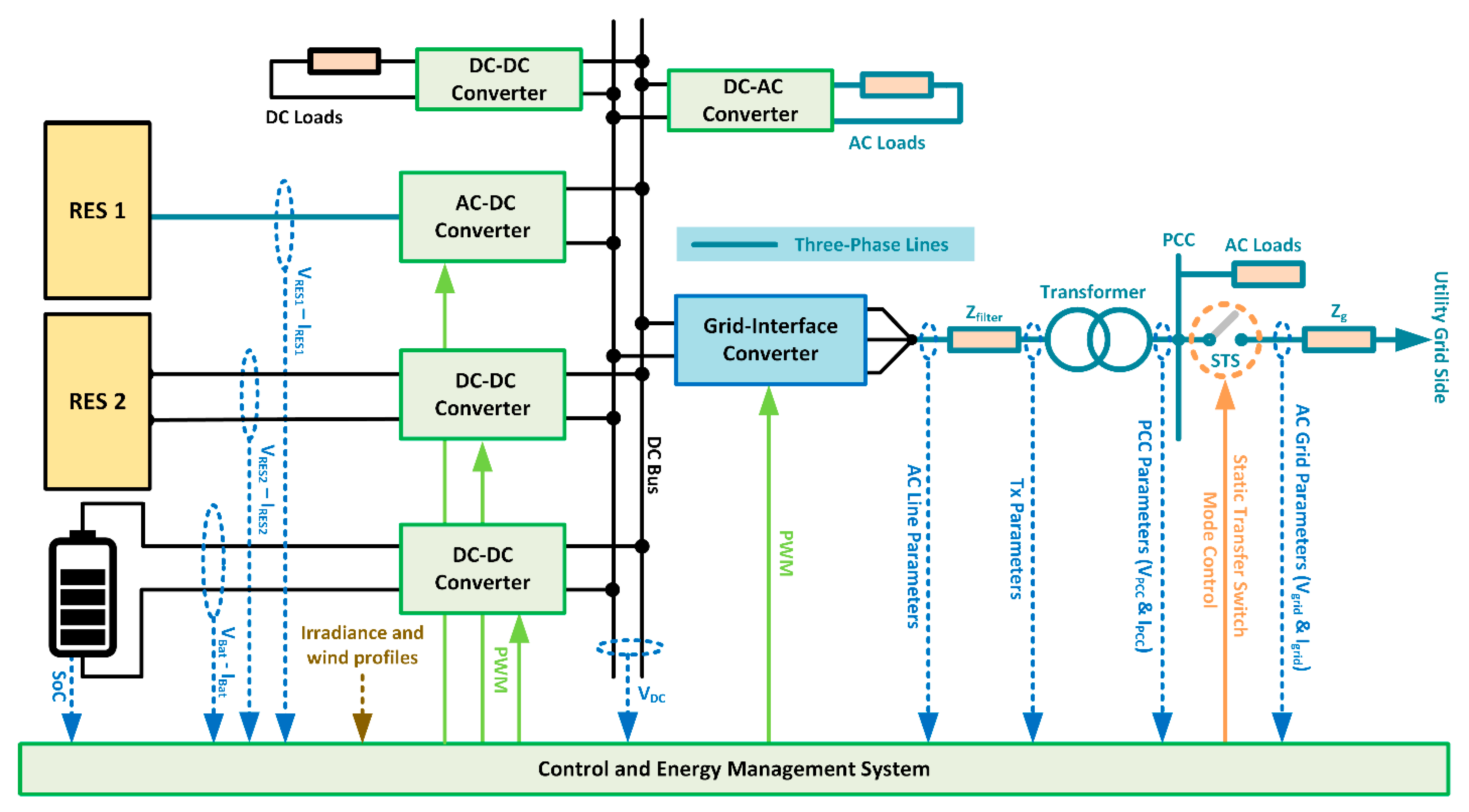
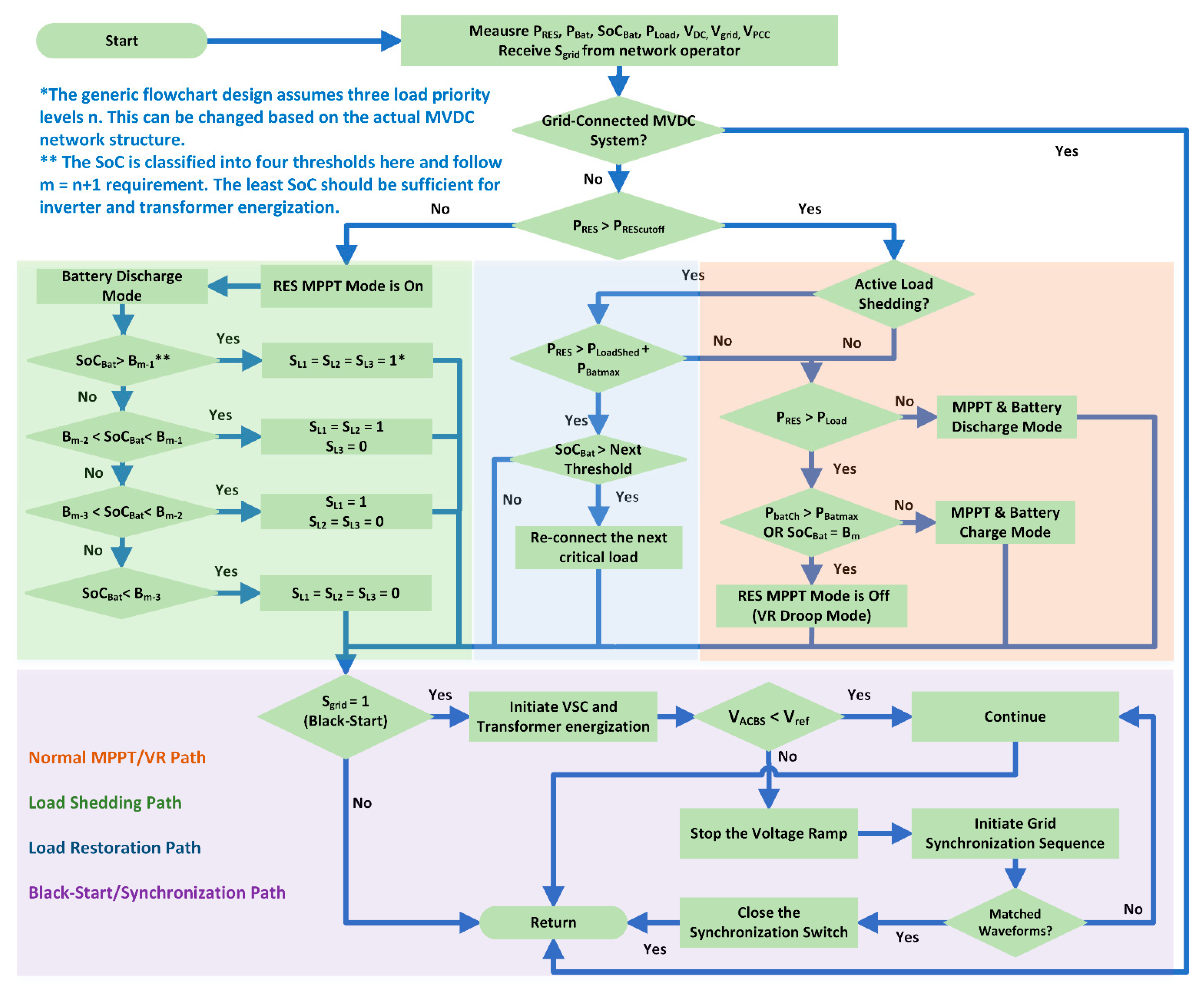

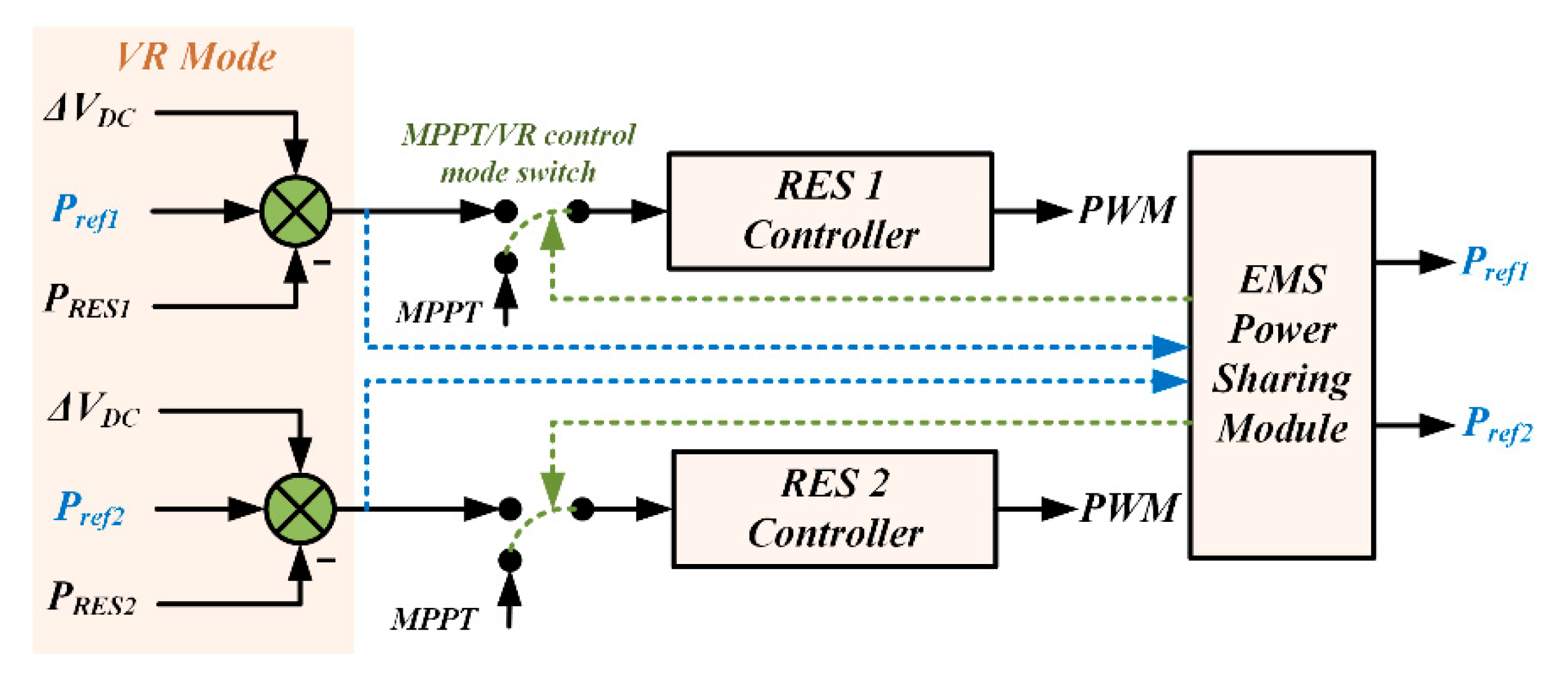


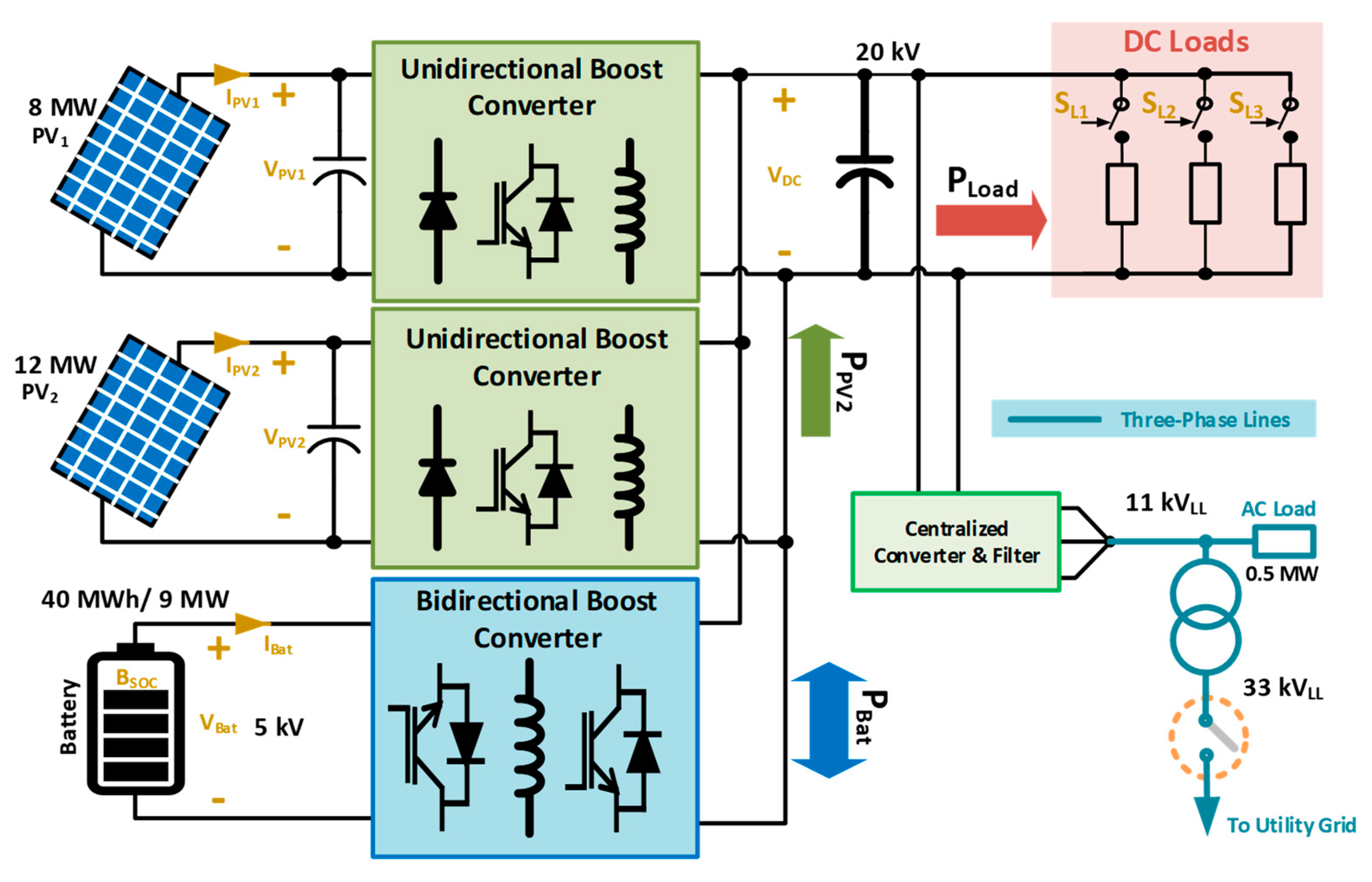

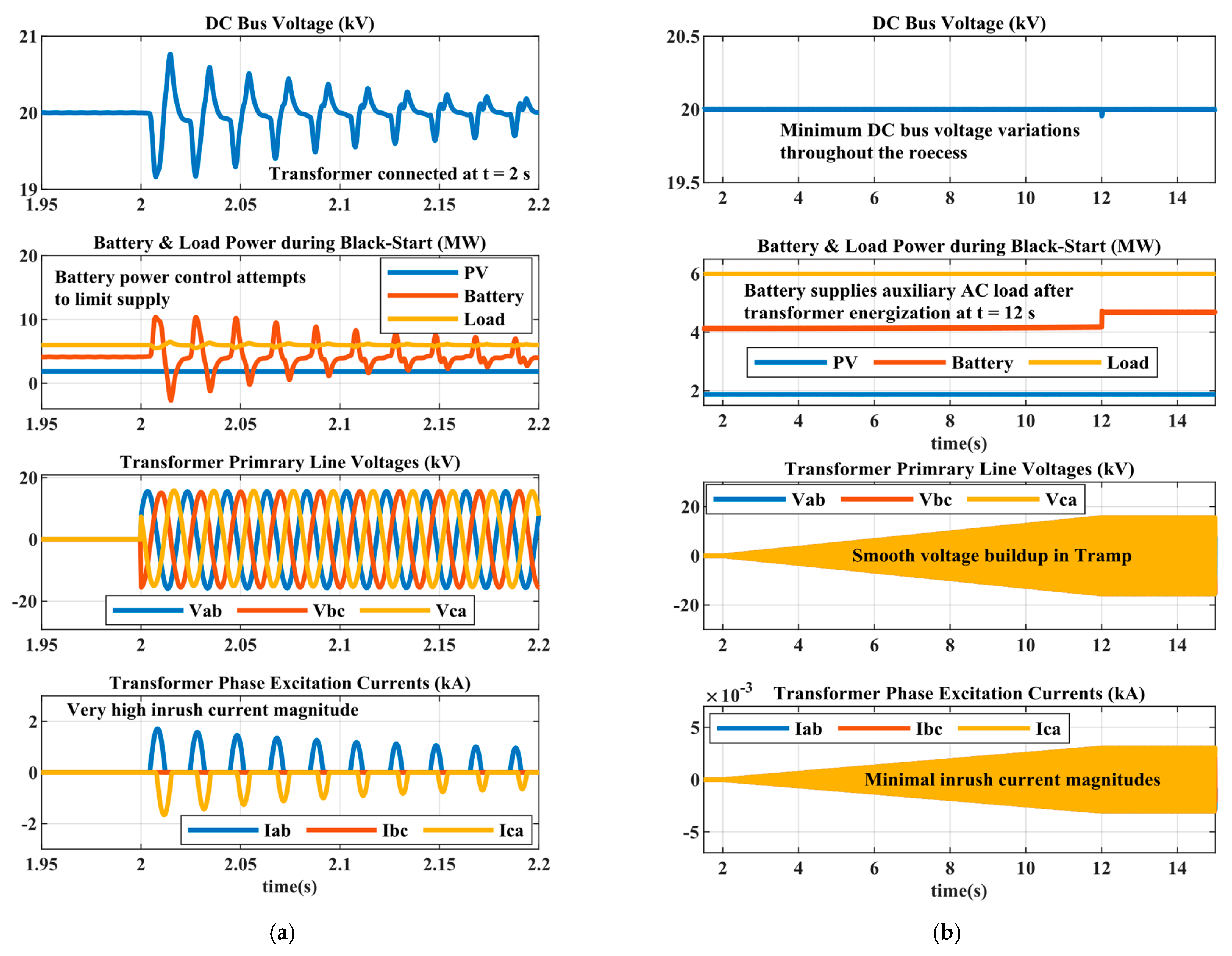
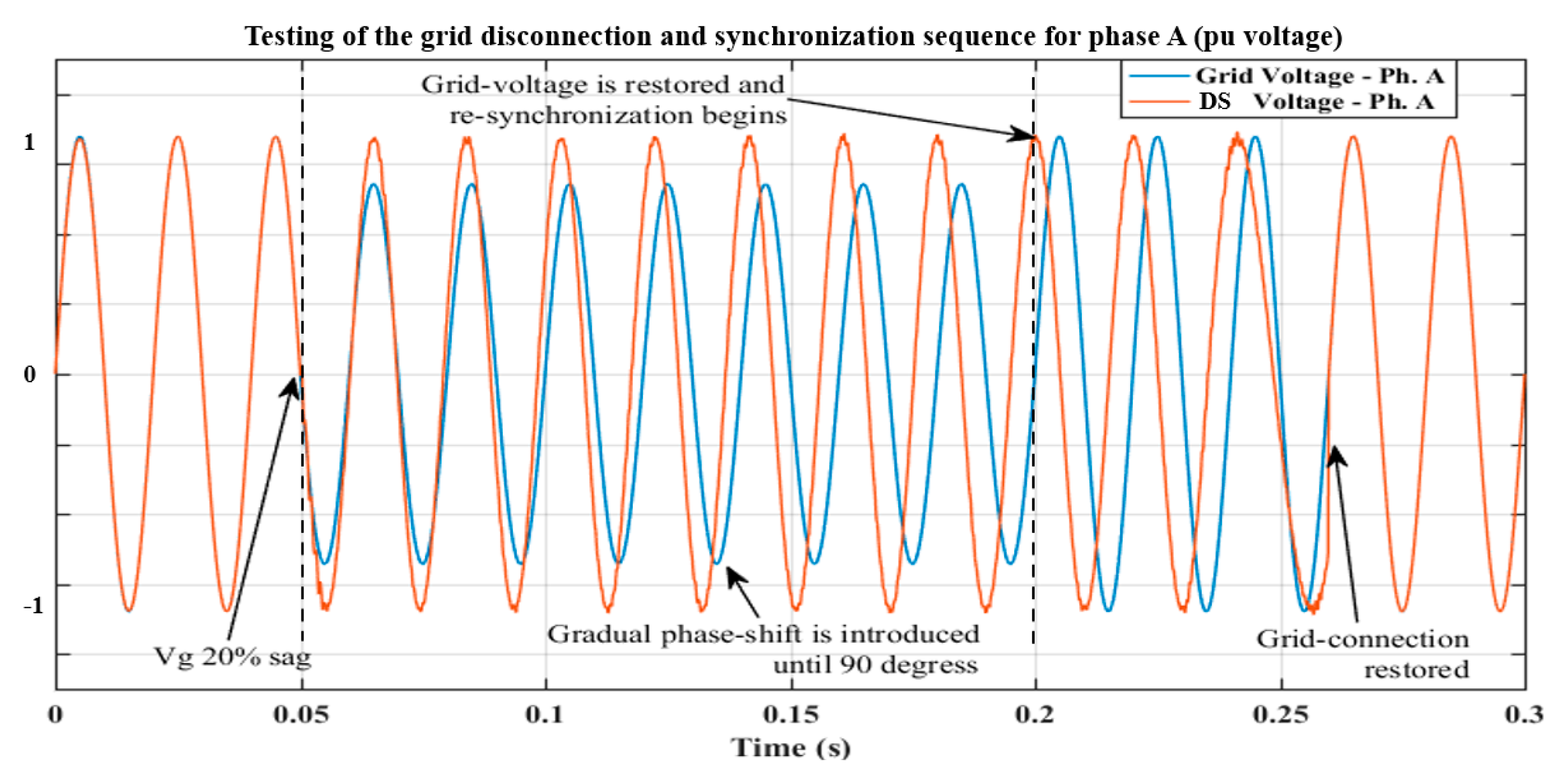

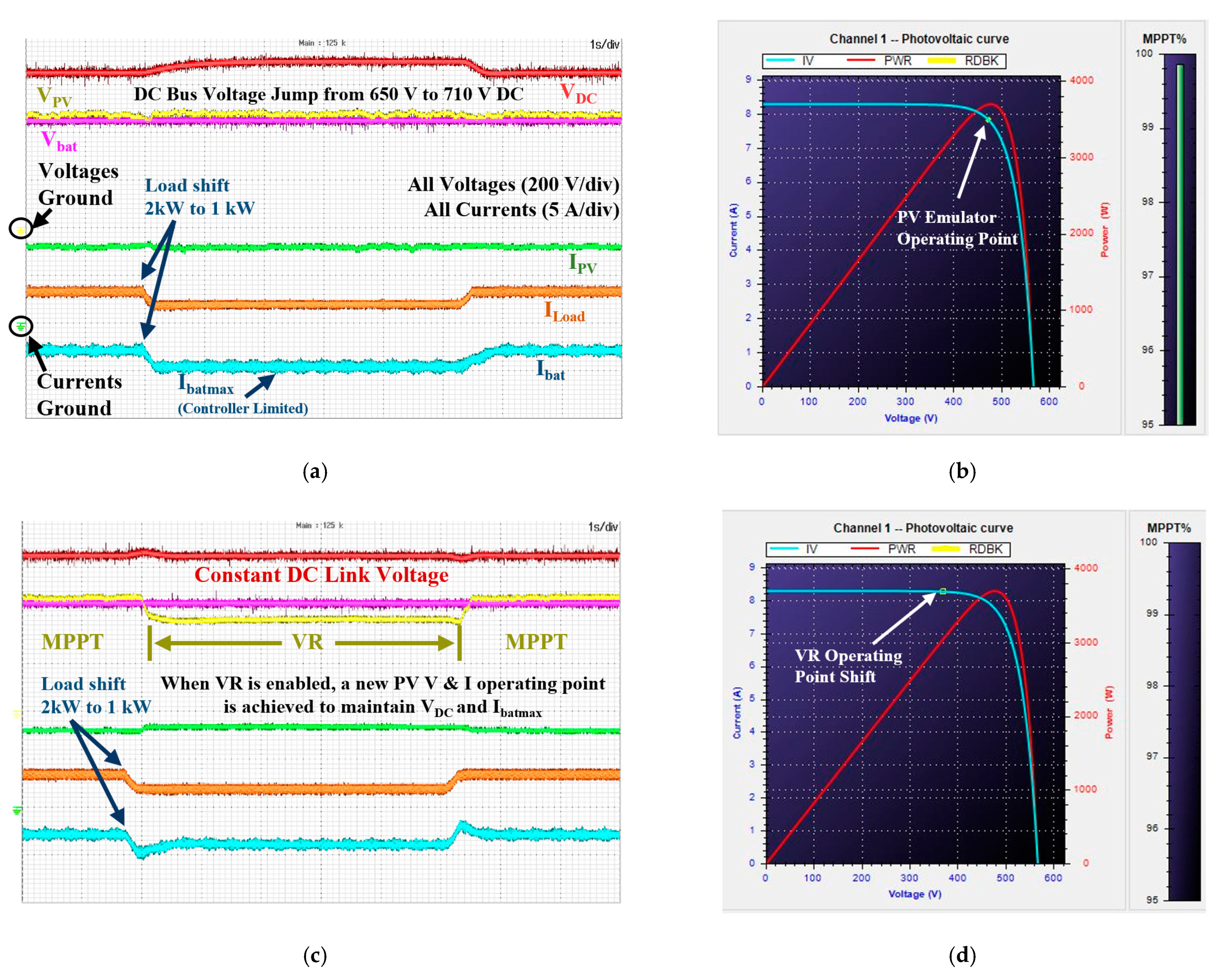
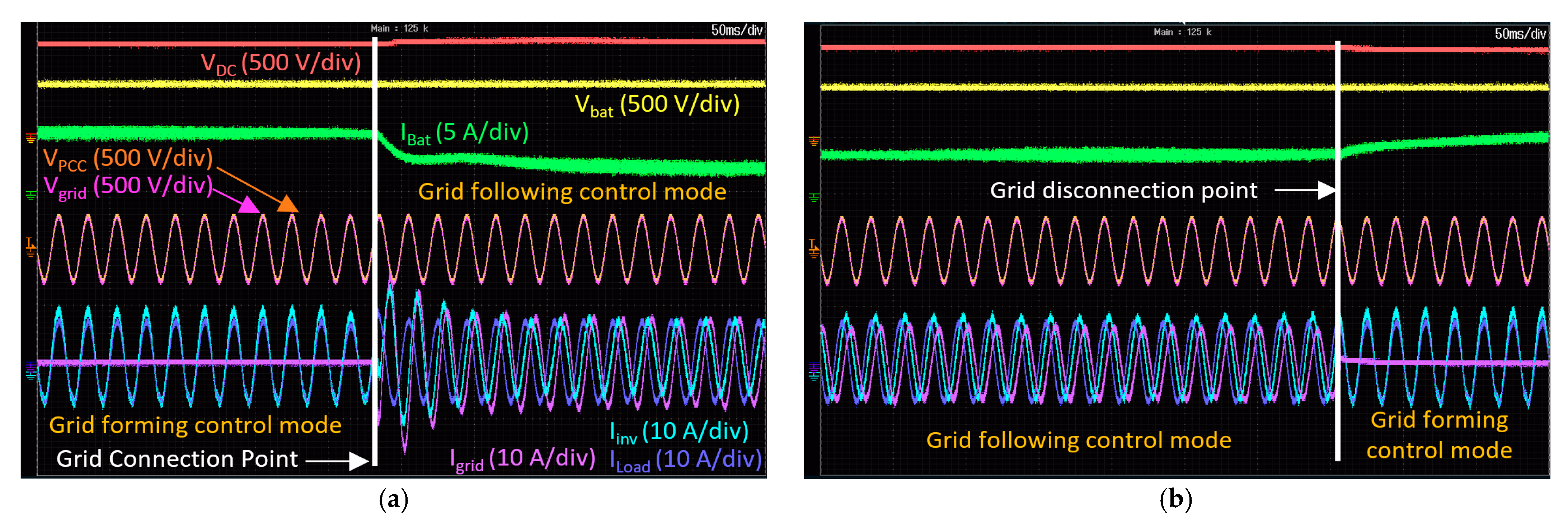
| Test | Objective |
|---|---|
| RES mode shift | Verifying MPPT-VR mode shift for DC bus voltage stabilization under variable environmental and loading conditions. |
| RES Power Sharing (multiple units) | Verifying power sharing functionality between multiple units in EMS VR mode. |
| Load shedding/restoration sequence | Verifying load clustering, shedding, and restoration sequence under variable RES output conditions. |
| Black-start and transformer energization | Verifying the MVDC network capability to energize the AC network after receiving black-start signal from utility with RES and storage contribution. |
| Grid synchronization sequence | Verifying the grid disconnection and restoration sequence for PCC synchronization. |
| Parameter (unit) | Value | Parameter (unit) | Value |
|---|---|---|---|
| PV1—PV2 Rating (MW) | 8–12 | PLoad DC Per Cluster (MW) | 2 (n = 3, total 6 MW) |
| PV1 and PV2 open-circuit Voltage (kV) | 1.5 | AC Auxiliary Load (MW) | 0.5 |
| VDC (kV) | 20 | SoC Thresholds (m = n + 1) | 20%, 50%, 70%, 100% |
| Vbat (kV) | 5 | Line Converter Voltage (kV) | 11 |
| Battery Capacity (MWh) | 40 | PCC Line Voltage (kV) | 33 |
| Pbatmax (MW) | 9 | Transformer Rating (MVA) | 25 |
| System frequency (Hz) | 50 | Soft Energization Tramp (s) | 10 |
| Voltage Regulation Test | Grid Synchronization Test | ||
|---|---|---|---|
| Parameter (unit) | Value | Parameter (unit) | Value |
| Maximum PV Power (kW) | 3.6 | PCC Line Voltage (V) | 346 |
| DC Bus Voltage (V) | 650 * | DC Bus Voltage (V) | 780 |
| Nominal Load Power (kW) | 2.0 | Nominal Load Power (kW) | 3.0 |
| Pbatmax (kW) | 2.2 | Pbatmax (kW) | 5.0 |
| Vbat (V) | 450 | Converter Pref (kW), Qref (kVAR) | 1.5, 2.0 |
| Disturbance Load Power (kW) | 1.0 | System Frequency (Hz) | 50 |
Publisher’s Note: MDPI stays neutral with regard to jurisdictional claims in published maps and institutional affiliations. |
© 2021 by the authors. Licensee MDPI, Basel, Switzerland. This article is an open access article distributed under the terms and conditions of the Creative Commons Attribution (CC BY) license (https://creativecommons.org/licenses/by/4.0/).
Share and Cite
Alassi, A.; Ahmed, K.; Egea-Àlvarez, A.; Ellabban, O. Innovative Energy Management System for MVDC Networks with Black-Start Capabilities. Energies 2021, 14, 2100. https://doi.org/10.3390/en14082100
Alassi A, Ahmed K, Egea-Àlvarez A, Ellabban O. Innovative Energy Management System for MVDC Networks with Black-Start Capabilities. Energies. 2021; 14(8):2100. https://doi.org/10.3390/en14082100
Chicago/Turabian StyleAlassi, Abdulrahman, Khaled Ahmed, Agustí Egea-Àlvarez, and Omar Ellabban. 2021. "Innovative Energy Management System for MVDC Networks with Black-Start Capabilities" Energies 14, no. 8: 2100. https://doi.org/10.3390/en14082100
APA StyleAlassi, A., Ahmed, K., Egea-Àlvarez, A., & Ellabban, O. (2021). Innovative Energy Management System for MVDC Networks with Black-Start Capabilities. Energies, 14(8), 2100. https://doi.org/10.3390/en14082100









